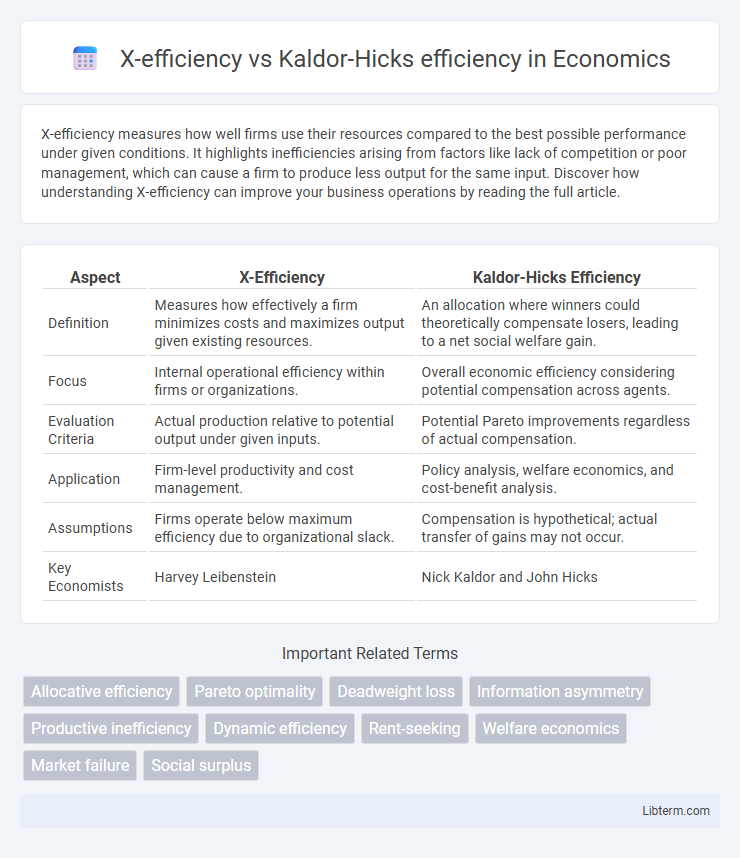X-efficiency measures how well firms use their resources compared to the best possible performance under given conditions. It highlights inefficiencies arising from factors like lack of competition or poor management, which can cause a firm to produce less output for the same input. Discover how understanding X-efficiency can improve your business operations by reading the full article.
Table of Comparison
| Aspect | X-Efficiency | Kaldor-Hicks Efficiency |
|---|---|---|
| Definition | Measures how effectively a firm minimizes costs and maximizes output given existing resources. | An allocation where winners could theoretically compensate losers, leading to a net social welfare gain. |
| Focus | Internal operational efficiency within firms or organizations. | Overall economic efficiency considering potential compensation across agents. |
| Evaluation Criteria | Actual production relative to potential output under given inputs. | Potential Pareto improvements regardless of actual compensation. |
| Application | Firm-level productivity and cost management. | Policy analysis, welfare economics, and cost-benefit analysis. |
| Assumptions | Firms operate below maximum efficiency due to organizational slack. | Compensation is hypothetical; actual transfer of gains may not occur. |
| Key Economists | Harvey Leibenstein | Nick Kaldor and John Hicks |
Introduction to Economic Efficiency Concepts
X-efficiency measures how well a firm minimizes costs and maximizes output given existing resources, emphasizing internal organizational performance and incentives. Kaldor-Hicks efficiency evaluates whether resource reallocation leads to net gains in social welfare, allowing for potential compensation to those disadvantaged by the change. Together, these concepts provide complementary perspectives on economic efficiency by analyzing both micro-level productivity and overall welfare improvements.
Defining X-Efficiency
X-efficiency measures a firm's ability to minimize waste and operate at maximum productive efficiency, reflecting internal organizational performance and management quality. It contrasts with Kaldor-Hicks efficiency, which evaluates economic outcomes based on potential compensation and overall welfare improvement without requiring equal benefit distribution. X-efficiency emphasizes real resource utilization and operational effectiveness rather than abstract welfare criteria.
Understanding Kaldor-Hicks Efficiency
Kaldor-Hicks efficiency evaluates resource allocation improvements where gains to winners exceed losses to losers, allowing potential compensation without requiring actual compensation, thus expanding overall economic welfare. Unlike X-efficiency, which emphasizes minimizing organizational inefficiencies and maximizing productivity within firms, Kaldor-Hicks efficiency prioritizes Pareto improvements in societal welfare by assessing net benefits across all individuals. This concept plays a crucial role in cost-benefit analysis by providing a practical criterion for policy decisions that increase aggregate efficiency despite distributional trade-offs.
Key Differences Between X-Efficiency and Kaldor-Hicks Efficiency
X-efficiency measures how well firms minimize costs and maximize output given their existing resources and technology, emphasizing internal operational efficiency, while Kaldor-Hicks efficiency evaluates resource allocation outcomes based on total net benefits to society, regardless of distribution. X-efficiency focuses on productive efficiency within organizations, whereas Kaldor-Hicks efficiency assesses allocative efficiency in economic policies by comparing gains and losses among affected parties. The key difference lies in X-efficiency's concern with firm-level performance under constraints versus Kaldor-Hicks efficiency's broader welfare-based criterion guiding potential compensation for improved aggregate efficiency.
Practical Examples of X-Efficiency in Markets
X-efficiency occurs when firms operate below their maximum productive potential due to organizational slack or lack of competitive pressure, as seen in monopolistic markets where companies face limited incentives to minimize costs. Practical examples include utility companies maintaining higher operational costs because regulated prices reduce the urgency to optimize efficiency. In contrast, Kaldor-Hicks efficiency evaluates resource allocation based on potential compensation between winners and losers, focusing on overall economic welfare rather than internal firm behavior.
Real-World Applications of Kaldor-Hicks Efficiency
Kaldor-Hicks efficiency plays a critical role in public policy and cost-benefit analysis by allowing decision-makers to evaluate projects where winners could potentially compensate losers, promoting overall welfare improvement despite unequal gains. It is widely applied in infrastructure development, environmental regulation, and urban planning to justify actions that increase total economic surplus even if some stakeholders bear losses. This practical approach contrasts with X-efficiency, which emphasizes minimizing organizational inefficiencies rather than assessing redistributive outcomes in societal resource allocation.
Advantages of X-Efficiency over Kaldor-Hicks Efficiency
X-efficiency emphasizes the realistic behavior of firms by accounting for managerial inefficiencies and motivational factors, leading to more accurate assessments of resource allocation in practical scenarios. Unlike Kaldor-Hicks efficiency, which relies on hypothetical compensation and potential Pareto improvements, X-efficiency captures actual productive performance and cost optimization within firms. This focus on internal inefficiencies allows policymakers and economists to identify real-world gains in productivity and competitiveness that Kaldor-Hicks efficiency may overlook.
Limitations and Criticisms of Both Efficiency Types
X-efficiency faces criticism for its difficulty in measurement and subjective interpretation of inefficiency sources, leading to challenges in practical application. Kaldor-Hicks efficiency is limited by its focus on potential compensation without guaranteeing actual compensation, raising concerns about fairness and distributional equity. Both efficiency types often overlook externalities and social welfare implications, restricting their effectiveness in comprehensive economic evaluation.
Policy Implications: X-Efficiency vs Kaldor-Hicks
X-efficiency highlights the need for policies that reduce organizational slack and promote productive efficiency within firms, emphasizing real resource utilization and managerial performance improvements. Kaldor-Hicks efficiency supports policies that facilitate potential Pareto improvements through cost-benefit analyses, allowing gains to exceed losses even if compensation does not occur. Policymakers must balance these approaches by encouraging firms to optimize internal efficiencies while assessing broader economic trade-offs and distributional effects for socially optimal outcomes.
Conclusion: Choosing the Right Efficiency Framework
X-efficiency emphasizes minimizing internal inefficiencies within firms by optimizing resource use and managerial practices, while Kaldor-Hicks efficiency focuses on overall welfare improvements through potential compensation of losers by winners in economic transactions. Choosing the right efficiency framework depends on the context: X-efficiency is critical for improving productivity and operational effectiveness within organizations, whereas Kaldor-Hicks efficiency guides broader policy decisions aiming at maximizing economic welfare despite distributional trade-offs. A balanced approach considers both frameworks to achieve practical organizational performance and equitable economic outcomes.
X-efficiency Infographic

 libterm.com
libterm.com